TESLA MODEL S 2014 Owner's manual (Europe)
Manufacturer: TESLA, Model Year: 2014, Model line: MODEL S, Model: TESLA MODEL S 2014Pages: 152, PDF Size: 17.5 MB
Page 101 of 152
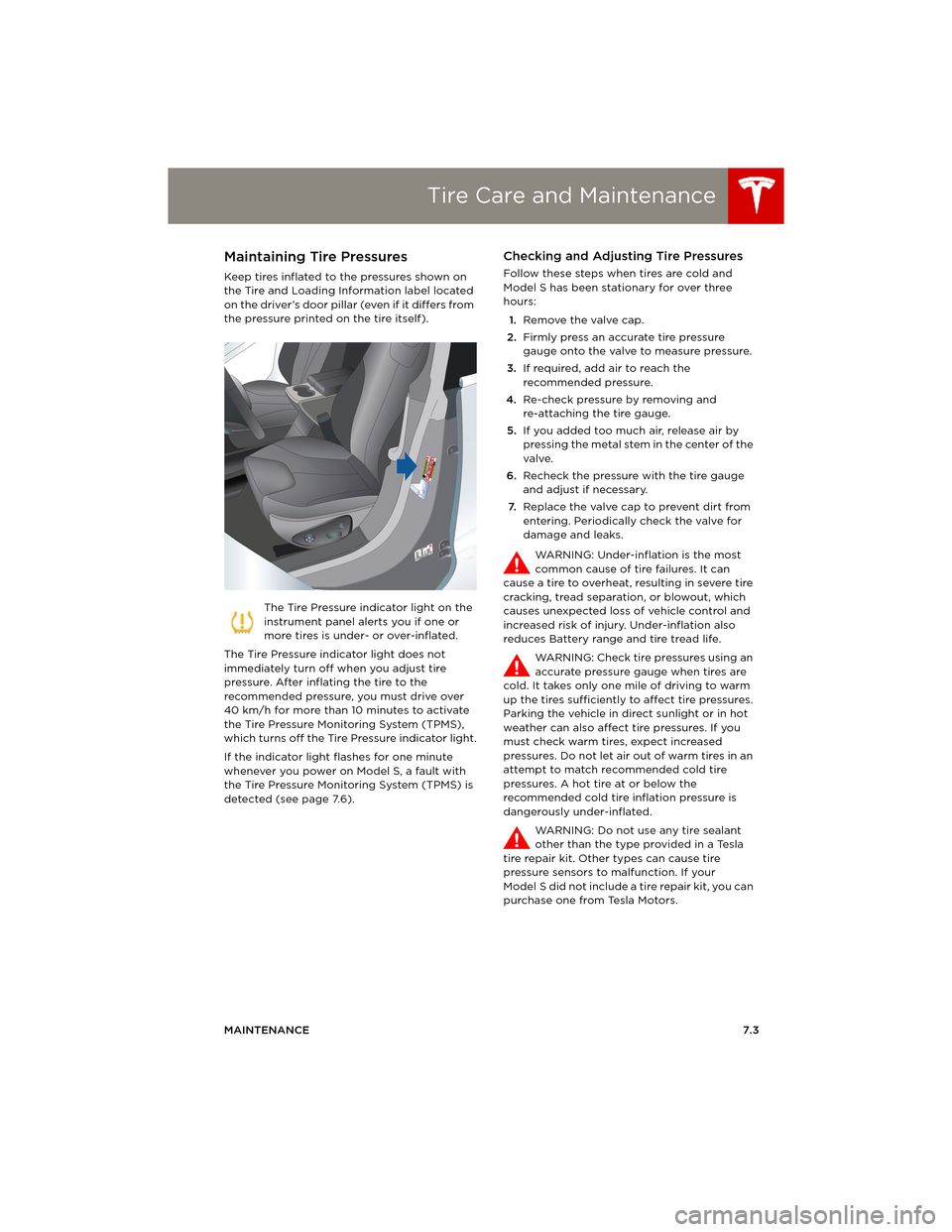
Tire Care and Maintenance
MAINTENANCE7.3
Tire Care and MaintenanceMaintaining Tire Pressures
Keep tires inflated to the pressures shown on
the Tire and Loading Information label located
on the driver’s door pillar (even if it differs from
the pressure printed on the tire itself).
The Tire Pressure indicator light on the
instrument panel alerts you if one or
more tires is under- or over-inflated.
The Tire Pressure indicator light does not
immediately turn off when you adjust tire
pressure. After inflating the tire to the
recommended pressure, you must drive over
40 km/h for more than 10 minutes to activate
the Tire Pressure Monitoring System (TPMS),
which turns off the Tire Pressure indicator light.
If the indicator light flashes for one minute
whenever you power on Model S, a fault with
the Tire Pressure Monitoring System (TPMS) is
detected (see page 7.6).
Checking and Adjusting Tire Pressures
Follow these steps when tires are cold and
Model S has been stationary for over three
hours:
1.Remove the valve cap.
2.Firmly press an accurate tire pressure
gauge onto the valve to measure pressure.
3.If required, add air to reach the
recommended pressure.
4.Re-check pressure by removing and
re-attaching the tire gauge.
5.If you added too much air, release air by
pressing the metal stem in the center of the
valve.
6.Recheck the pressure with the tire gauge
and adjust if necessary.
7.Replace the valve cap to prevent dirt from
entering. Periodically check the valve for
damage and leaks.
WARNING: Under-inflation is the most
common cause of tire failures. It can
cause a tire to overheat, resulting in severe tire
cracking, tread separation, or blowout, which
causes unexpected loss of vehicle control and
increased risk of injury. Under-inflation also
reduces Battery range and tire tread life.
WARNING: Check tire pressures using an
accurate pressure gauge when tires are
cold. It takes only one mile of driving to warm
up the tires sufficiently to affect tire pressures.
Parking the vehicle in direct sunlight or in hot
weather can also affect tire pressures. If you
must check warm tires, expect increased
pressures. Do not let air out of warm tires in an
attempt to match recommended cold tire
pressures. A hot tire at or below the
recommended cold tire inflation pressure is
dangerously under-inflated.
WARNING: Do not use any tire sealant
other than the type provided in a Tesla
tire repair kit. Other types can cause tire
pressure sensors to malfunction. If your
Model S did not include a tire repair kit, you can
purchase one from Tesla Motors.
book.book Page 3 Friday, July 19, 2013 12:53 PM
Page 102 of 152
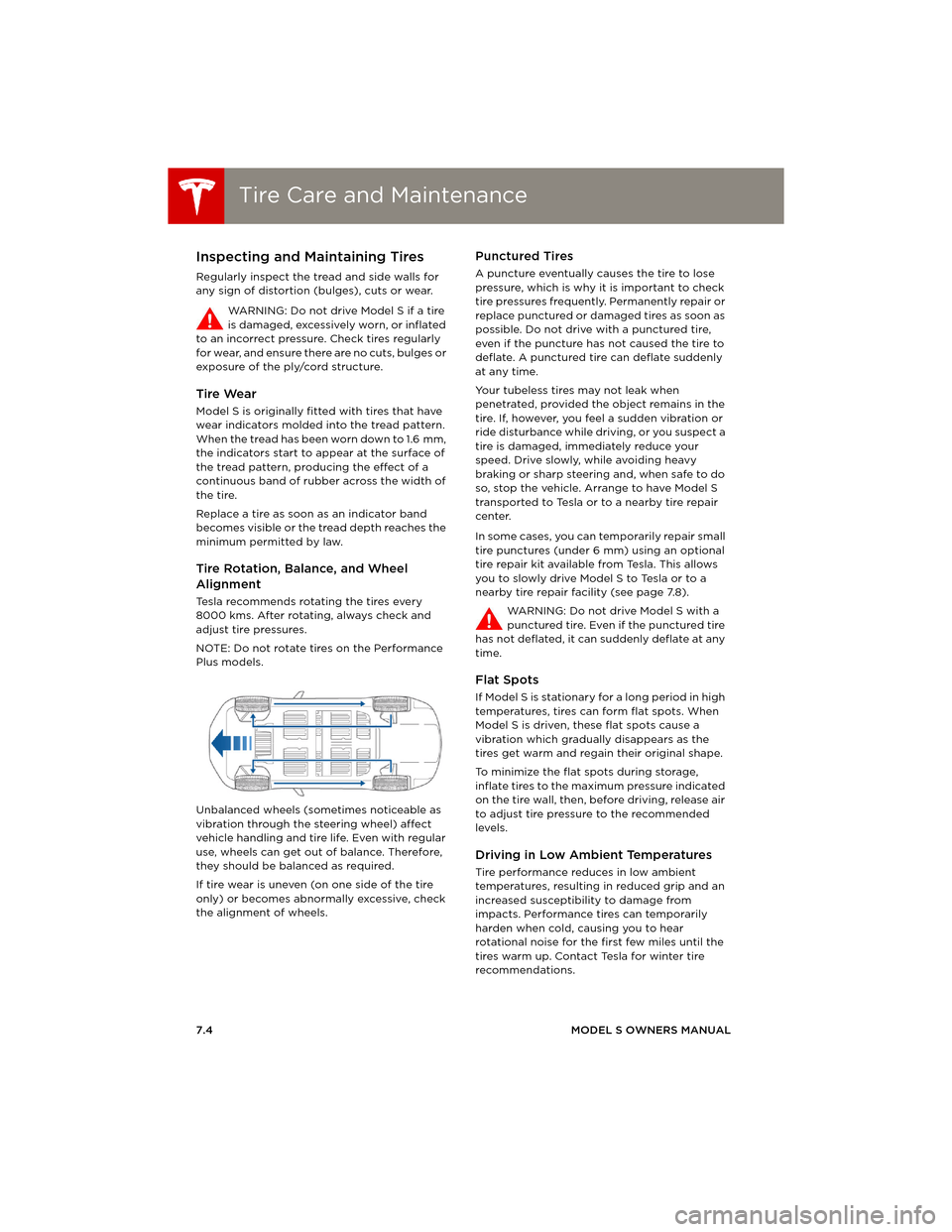
Tire Care and MaintenanceTire Care and Maintenance
7.4MODEL S OWNERS MANUAL
Inspecting and Maintaining Tires
Regularly inspect the tread and side walls for
any sign of distortion (bulges), cuts or wear.
WARNING: Do not drive Model S if a tire
is damaged, excessively worn, or inflated
to an incorrect pressure. Check tires regularly
for wear, and ensure there are no cuts, bulges or
exposure of the ply/cord structure.
Tire Wear
Model S is originally fitted with tires that have
wear indicators molded into the tread pattern.
When the tread has been worn down to 1.6 mm,
the indicators start to appear at the surface of
the tread pattern, producing the effect of a
continuous band of rubber across the width of
the tire.
Replace a tire as soon as an indicator band
becomes visible or the tread depth reaches the
minimum permitted by law.
Tire Rotation, Balance, and Wheel
Alignment
Tesla recommends rotating the tires every
8000 kms. After rotating, always check and
adjust tire pressures.
NOTE: Do not rotate tires on the Performance
Plus models.
Unbalanced wheels (sometimes noticeable as
vibration through the steering wheel) affect
vehicle handling and tire life. Even with regular
use, wheels can get out of balance. Therefore,
they should be balanced as required.
If tire wear is uneven (on one side of the tire
only) or becomes abnormally excessive, check
the alignment of wheels.
Punctured Tires
A puncture eventually causes the tire to lose
pressure, which is why it is important to check
tire pressures frequently. Permanently repair or
replace punctured or damaged tires as soon as
possible. Do not drive with a punctured tire,
even if the puncture has not caused the tire to
deflate. A punctured tire can deflate suddenly
at any time.
Your tubeless tires may not leak when
penetrated, provided the object remains in the
tire. If, however, you feel a sudden vibration or
ride disturbance while driving, or you suspect a
tire is damaged, immediately reduce your
speed. Drive slowly, while avoiding heavy
braking or sharp steering and, when safe to do
so, stop the vehicle. Arrange to have Model S
transported to Tesla or to a nearby tire repair
center.
In some cases, you can temporarily repair small
tire punctures (under 6 mm) using an optional
tire repair kit available from Tesla. This allows
you to slowly drive Model S to Tesla or to a
nearby tire repair facility (see page 7.8).
WARNING: Do not drive Model S with a
punctured tire. Even if the punctured tire
has not deflated, it can suddenly deflate at any
time.
Flat Spots
If Model S is stationary for a long period in high
temperatures, tires can form flat spots. When
Model S is driven, these flat spots cause a
vibration which gradually disappears as the
tires get warm and regain their original shape.
To minimize the flat spots during storage,
inflate tires to the maximum pressure indicated
on the tire wall, then, before driving, release air
to adjust tire pressure to the recommended
levels.
Driving in Low Ambient Temperatures
Tire performance reduces in low ambient
temperatures, resulting in reduced grip and an
increased susceptibility to damage from
impacts. Performance tires can temporarily
harden when cold, causing you to hear
rotational noise for the first few miles until the
tires warm up. Contact Tesla for winter tire
recommendations.
book.book Page 4 Friday, July 19, 2013 12:53 PM
Page 103 of 152
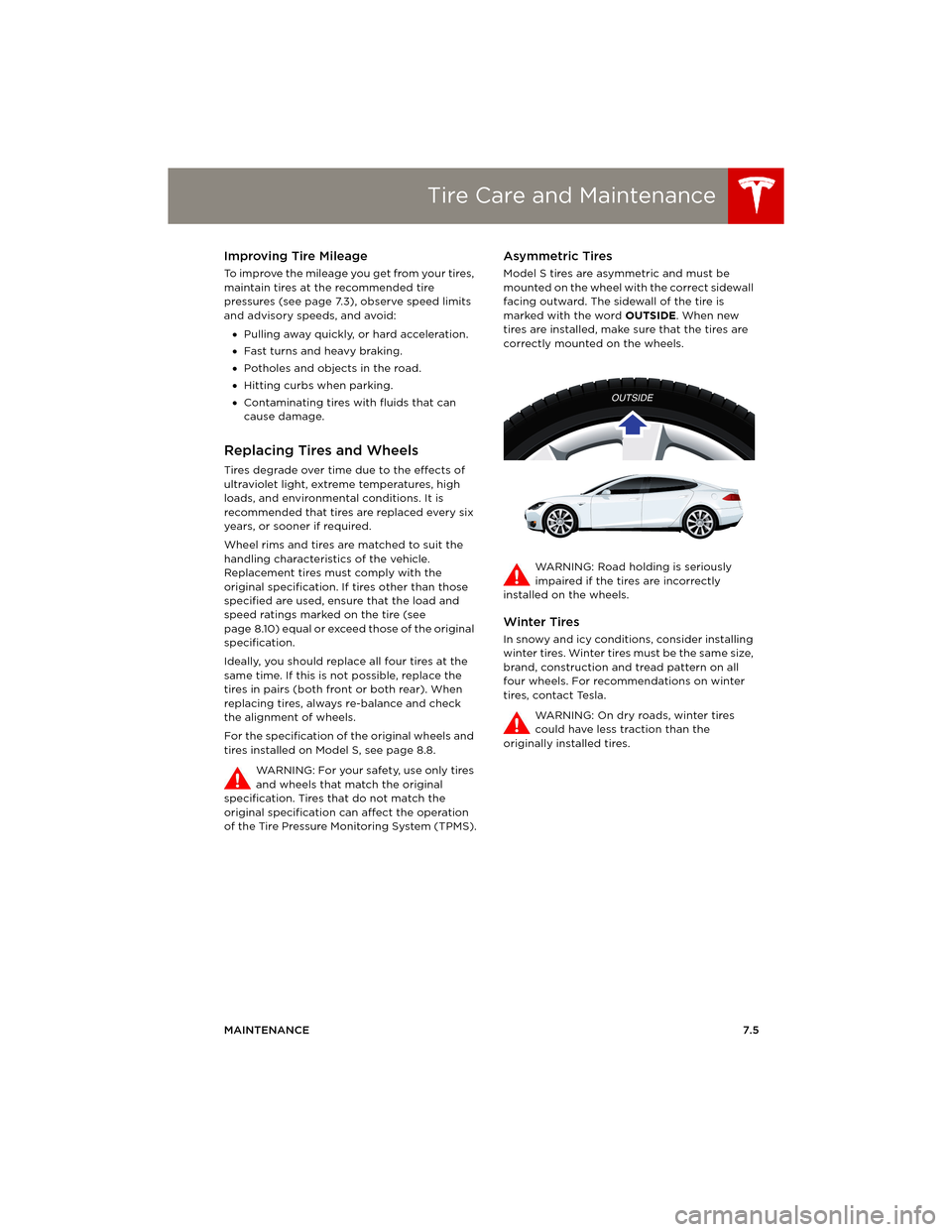
Tire Care and Maintenance
MAINTENANCE7.5
Improving Tire Mileage
To improve the mileage you get from your tires,
maintain tires at the recommended tire
pressures (see page 7.3), observe speed limits
and advisory speeds, and avoid:
•Pulling away quickly, or hard acceleration.
•Fast turns and heavy braking.
•Potholes and objects in the road.
•Hitting curbs when parking.
•Contaminating tires with fluids that can
cause damage.
Replacing Tires and Wheels
Tires degrade over time due to the effects of
ultraviolet light, extreme temperatures, high
loads, and environmental conditions. It is
recommended that tires are replaced every six
years, or sooner if required.
Wheel rims and tires are matched to suit the
handling characteristics of the vehicle.
Replacement tires must comply with the
original specification. If tires other than those
specified are used, ensure that the load and
speed ratings marked on the tire (see
page 8.10) equal or exceed those of the original
specification.
Ideally, you should replace all four tires at the
same time. If this is not possible, replace the
tires in pairs (both front or both rear). When
replacing tires, always re-balance and check
the alignment of wheels.
For the specification of the original wheels and
tires installed on Model S, see page 8.8.
WARNING: For your safety, use only tires
and wheels that match the original
specification. Tires that do not match the
original specification can affect the operation
of the Tire Pressure Monitoring System (TPMS).
Asymmetric Tires
Model S tires are asymmetric and must be
mounted on the wheel with the correct sidewall
facing outward. The sidewall of the tire is
marked with the word OUTSIDE. When new
tires are installed, make sure that the tires are
correctly mounted on the wheels.
WARNING: Road holding is seriously
impaired if the tires are incorrectly
installed on the wheels.
Winter Tires
In snowy and icy conditions, consider installing
winter tires. Winter tires must be the same size,
brand, construction and tread pattern on all
four wheels. For recommendations on winter
tires, contact Tesla.
WARNING: On dry roads, winter tires
could have less traction than the
originally installed tires.
book.book Page 5 Friday, July 19, 2013 12:53 PM
Page 104 of 152
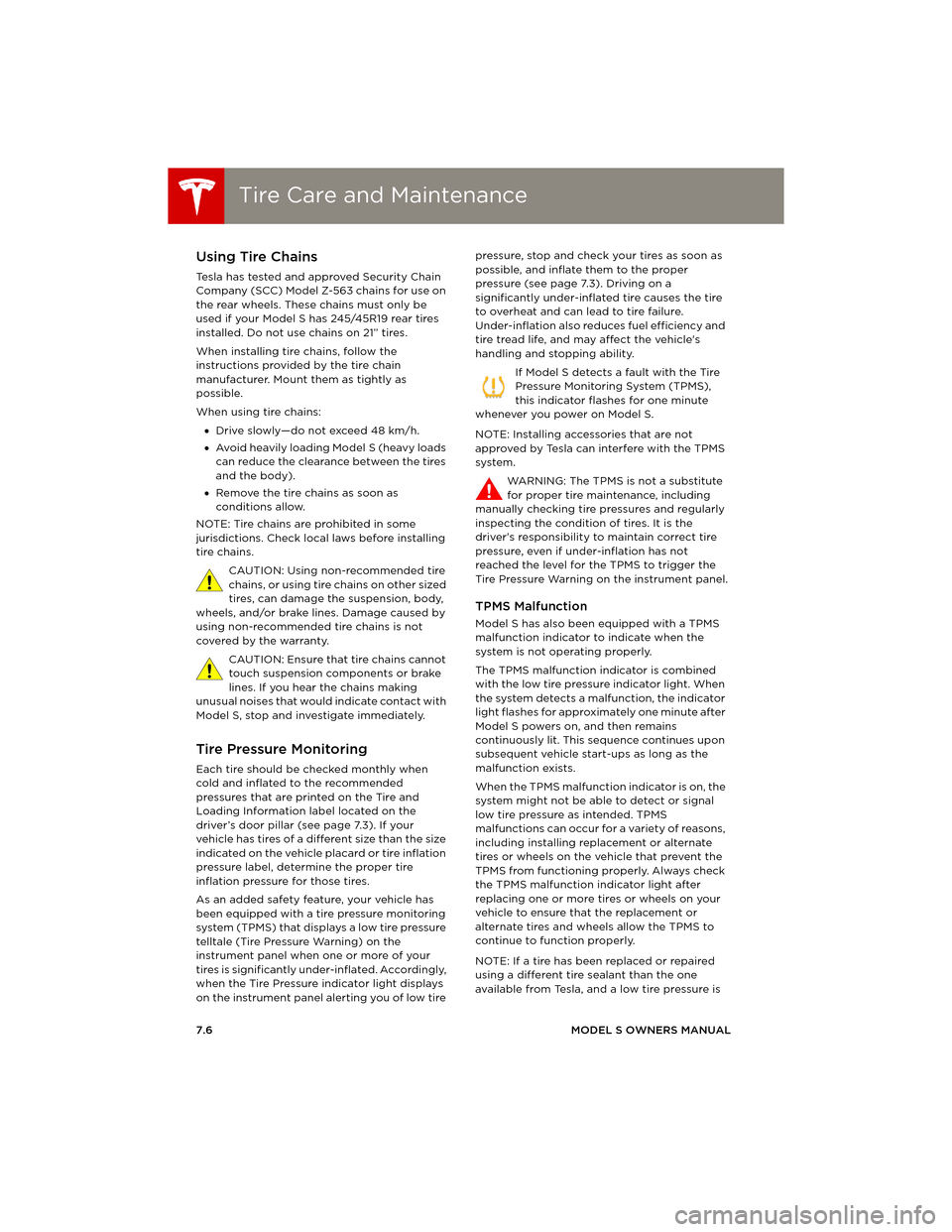
Tire Care and MaintenanceTire Care and Maintenance
7.6MODEL S OWNERS MANUAL
Using Tire Chains
Tesla has tested and approved Security Chain
Company (SCC) Model Z-563 chains for use on
the rear wheels. These chains must only be
used if your Model S has 245/45R19 rear tires
installed. Do not use chains on 21” tires.
When installing tire chains, follow the
instructions provided by the tire chain
manufacturer. Mount them as tightly as
possible.
When using tire chains:
•Drive slowly—do not exceed 48 km/h.
•Avoid heavily loading Model S (heavy loads
can reduce the clearance between the tires
and the body).
•Remove the tire chains as soon as
conditions allow.
NOTE: Tire chains are prohibited in some
jurisdictions. Check local laws before installing
tire chains.
CAUTION: Using non-recommended tire
chains, or using tire chains on other sized
tires, can damage the suspension, body,
wheels, and/or brake lines. Damage caused by
using non-recommended tire chains is not
covered by the warranty.
CAUTION: Ensure that tire chains cannot
touch suspension components or brake
lines. If you hear the chains making
unusual noises that would indicate contact with
Model S, stop and investigate immediately.
Tire Pressure Monitoring
Each tire should be checked monthly when
cold and inflated to the recommended
pressures that are printed on the Tire and
Loading Information label located on the
driver’s door pillar (see page 7.3). If your
vehicle has tires of a different size than the size
indicated on the vehicle placard or tire inflation
pressure label, determine the proper tire
inflation pressure for those tires.
As an added safety feature, your vehicle has
been equipped with a tire pressure monitoring
system (TPMS) that displays a low tire pressure
telltale (Tire Pressure Warning) on the
instrument panel when one or more of your
tires is significantly under-inflated. Accordingly,
when the Tire Pressure indicator light displays
on the instrument panel alerting you of low tire pressure, stop and check your tires as soon as
possible, and inflate them to the proper
pressure (see page 7.3). Driving on a
significantly under-inflated tire causes the tire
to overheat and can lead to tire failure.
Under-inflation also reduces fuel efficiency and
tire tread life, and may affect the vehicle's
handling and stopping ability.
If Model S detects a fault with the Tire
Pressure Monitoring System (TPMS),
this indicator flashes for one minute
whenever you power on Model S.
NOTE: Installing accessories that are not
approved by Tesla can interfere with the TPMS
system.
WARNING: The TPMS is not a substitute
for proper tire maintenance, including
manually checking tire pressures and regularly
inspecting the condition of tires. It is the
driver's responsibility to maintain correct tire
pressure, even if under-inflation has not
reached the level for the TPMS to trigger the
Tire Pressure Warning on the instrument panel.
TPMS Malfunction
Model S has also been equipped with a TPMS
malfunction indicator to indicate when the
system is not operating properly.
The TPMS malfunction indicator is combined
with the low tire pressure indicator light. When
the system detects a malfunction, the indicator
light flashes for approximately one minute after
Model S powers on, and then remains
continuously lit. This sequence continues upon
subsequent vehicle start-ups as long as the
malfunction exists.
When the TPMS malfunction indicator is on, the
system might not be able to detect or signal
low tire pressure as intended. TPMS
malfunctions can occur for a variety of reasons,
including installing replacement or alternate
tires or wheels on the vehicle that prevent the
TPMS from functioning properly. Always check
the TPMS malfunction indicator light after
replacing one or more tires or wheels on your
vehicle to ensure that the replacement or
alternate tires and wheels allow the TPMS to
continue to function properly.
NOTE: If a tire has been replaced or repaired
using a different tire sealant than the one
available from Tesla, and a low tire pressure is
book.book Page 6 Friday, July 19, 2013 12:53 PM
Page 105 of 152
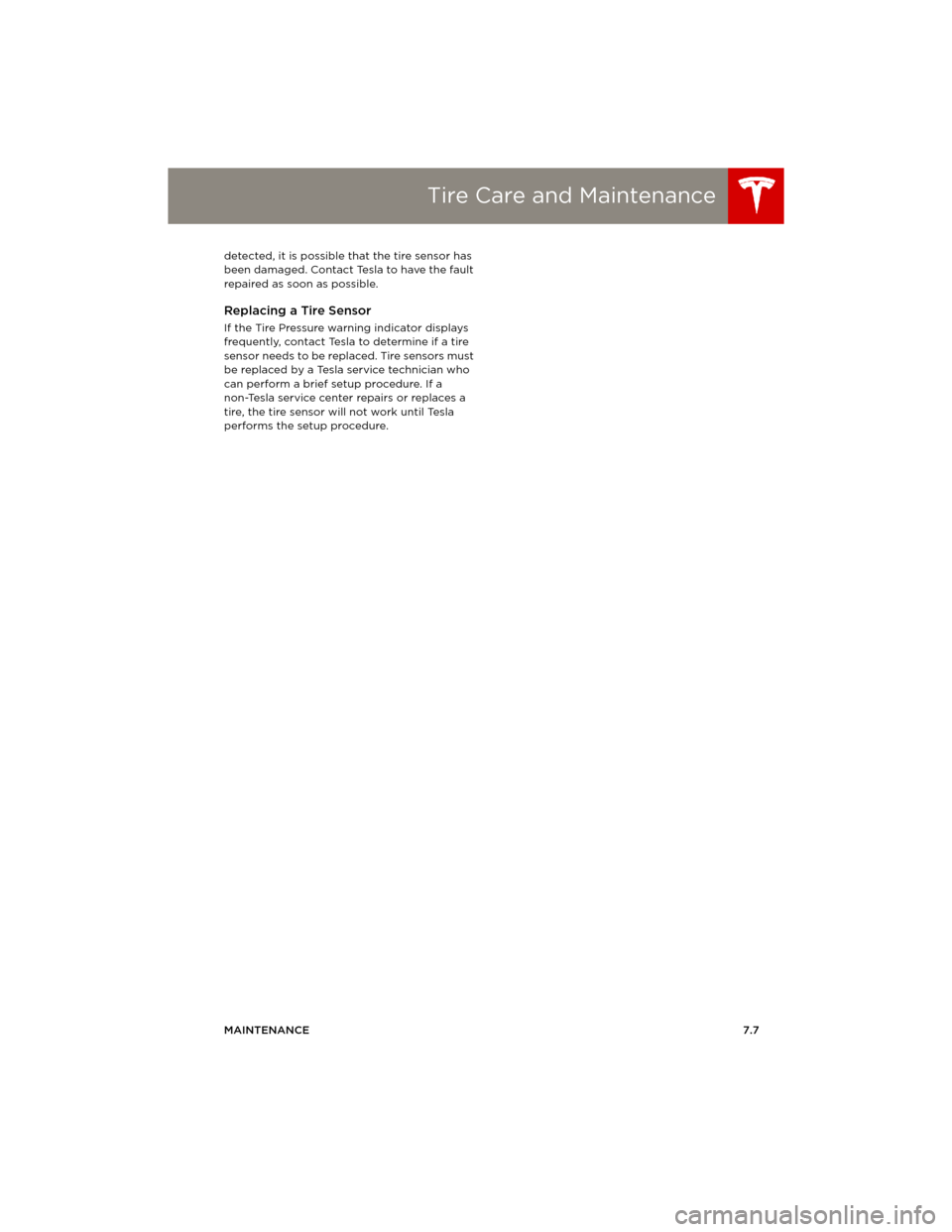
Tire Care and Maintenance
MAINTENANCE7.7 detected, it is possible that the tire sensor has
been damaged. Contact Tesla to have the fault
repaired as soon as possible.
Replacing a Tire Sensor
If the Tire Pressure warning indicator displays
frequently, contact Tesla to determine if a tire
sensor needs to be replaced. Tire sensors must
be replaced by a Tesla service technician who
can perform a brief setup procedure. If a
non-Tesla service center repairs or replaces a
tire, the tire sensor will not work until Tesla
performs the setup procedure.
book.book Page 7 Friday, July 19, 2013 12:53 PM
Page 106 of 152
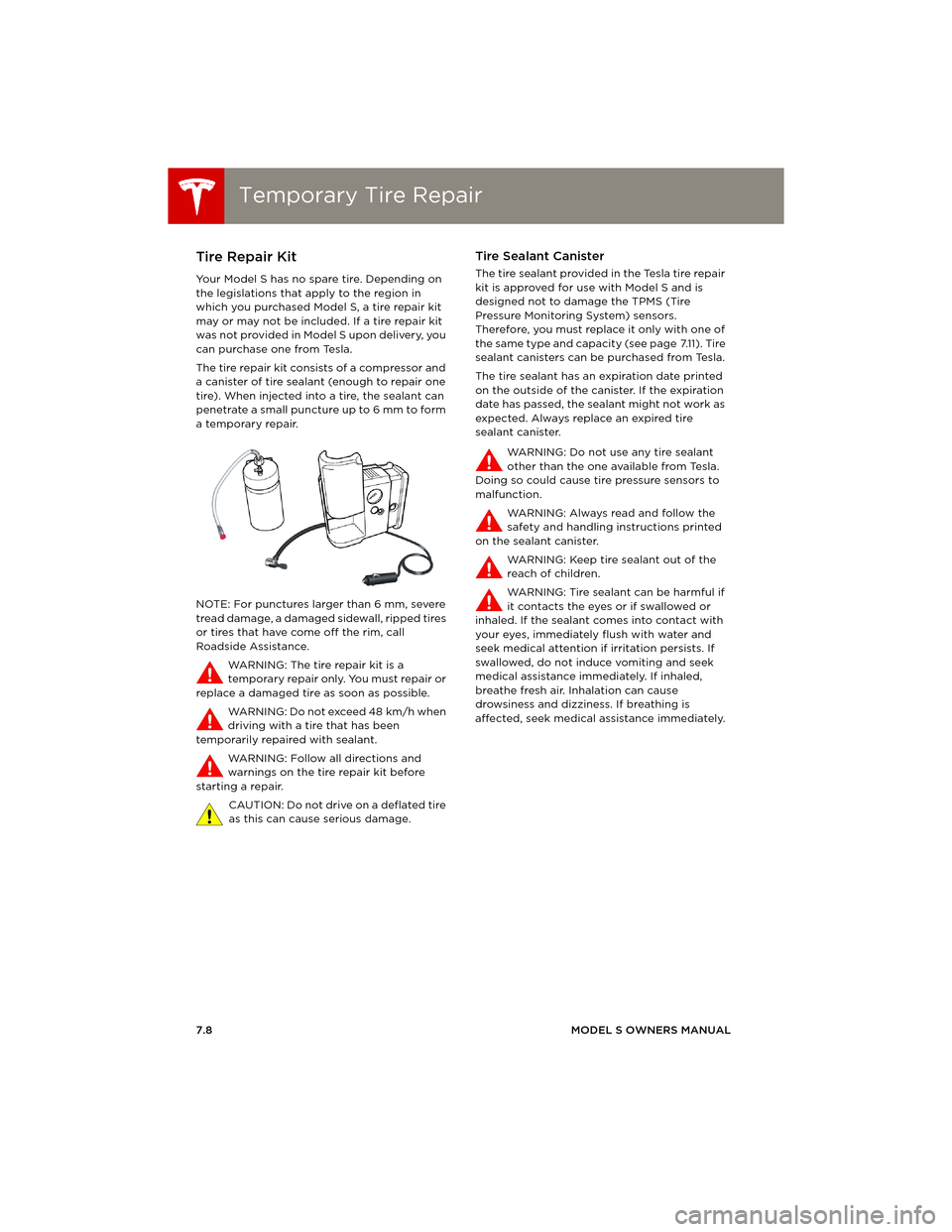
Temporary Tire RepairTemporary Tire Repair
7.8MODEL S OWNERS MANUAL
Te m p o r a r y T i r e R e p a i rTire Repair Kit
Your Model S has no spare tire. Depending on
the legislations that apply to the region in
which you purchased Model S, a tire repair kit
may or may not be included. If a tire repair kit
was not provided in Model S upon delivery, you
can purchase one from Tesla.
The tire repair kit consists of a compressor and
a canister of tire sealant (enough to repair one
tire). When injected into a tire, the sealant can
penetrate a small puncture up to 6 mm to form
a temporary repair.
NOTE: For punctures larger than 6 mm, severe
tread damage, a damaged sidewall, ripped tires
or tires that have come off the rim, call
Roadside Assistance.
WARNING: The tire repair kit is a
temporary repair only. You must repair or
replace a damaged tire as soon as possible.
WARNING: Do not exceed 48 km/h when
driving with a tire that has been
temporarily repaired with sealant.
WARNING: Follow all directions and
warnings on the tire repair kit before
starting a repair.
CAUTION: Do not drive on a deflated tire
as this can cause serious damage.
Tire Sealant Canister
The tire sealant provided in the Tesla tire repair
kit is approved for use with Model S and is
designed not to damage the TPMS (Tire
Pressure Monitoring System) sensors.
Therefore, you must replace it only with one of
the same type and capacity (see page 7.11). Tire
sealant canisters can be purchased from Tesla.
The tire sealant has an expiration date printed
on the outside of the canister. If the expiration
date has passed, the sealant might not work as
expected. Always replace an expired tire
sealant canister.
WARNING: Do not use any tire sealant
other than the one available from Tesla.
Doing so could cause tire pressure sensors to
malfunction.
WARNING: Always read and follow the
safety and handling instructions printed
on the sealant canister.
WARNING: Keep tire sealant out of the
reach of children.
WARNING: Tire sealant can be harmful if
it contacts the eyes or if swallowed or
inhaled. If the sealant comes into contact with
your eyes, immediately flush with water and
seek medical attention if irritation persists. If
swallowed, do not induce vomiting and seek
medical assistance immediately. If inhaled,
breathe fresh air. Inhalation can cause
drowsiness and dizziness. If breathing is
affected, seek medical assistance immediately.
book.book Page 8 Friday, July 19, 2013 12:53 PM
Page 107 of 152
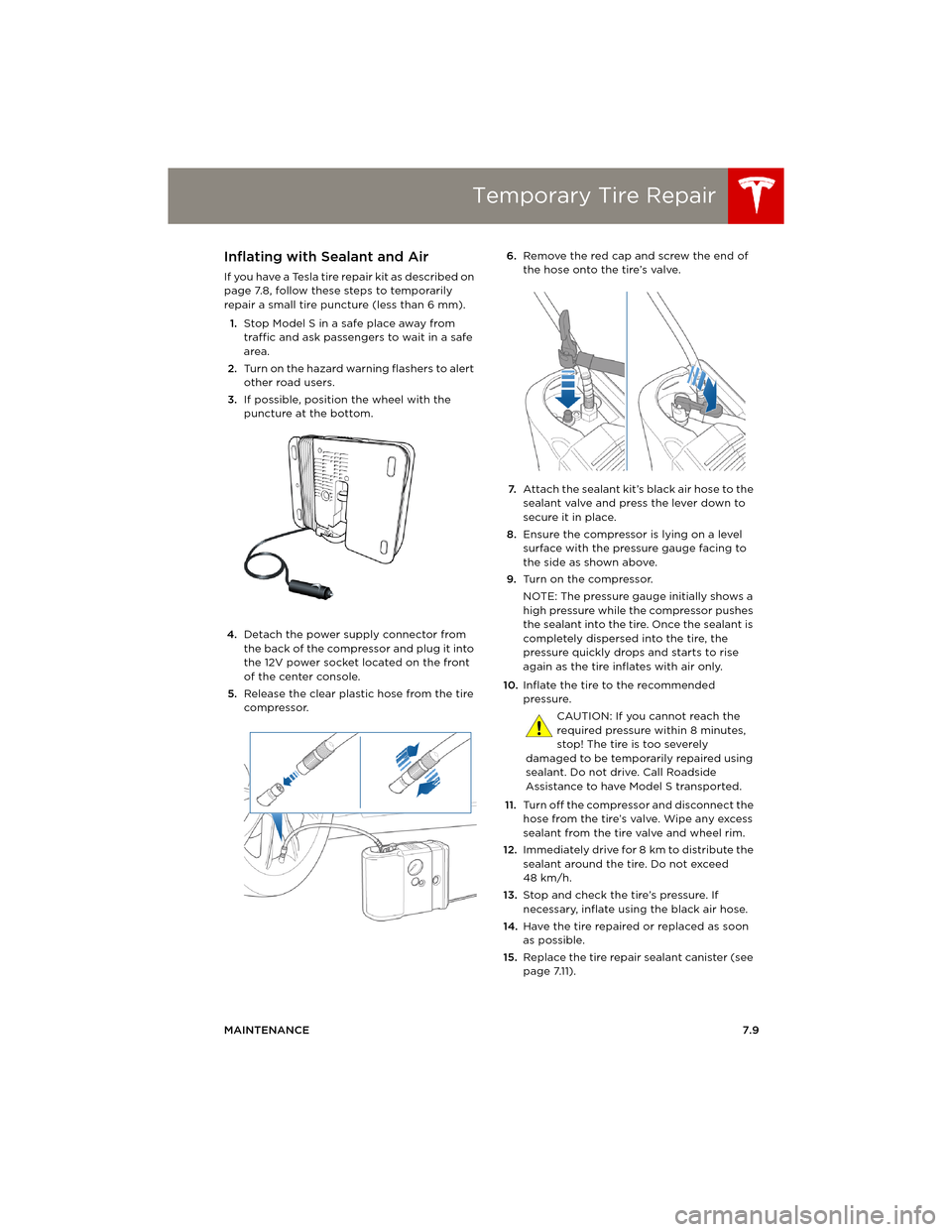
Temporary Tire Repair
MAINTENANCE7.9
Inflating with Sealant and Air
If you have a Tesla tire repair kit as described on
page 7.8, follow these steps to temporarily
repair a small tire puncture (less than 6 mm).
1.Stop Model S in a safe place away from
traffic and ask passengers to wait in a safe
area.
2.Turn on the hazard warning flashers to alert
other road users.
3.If possible, position the wheel with the
puncture at the bottom.
4.Detach the power supply connector from
the back of the compressor and plug it into
the 12V power socket located on the front
of the center console.
5.Release the clear plastic hose from the tire
compressor.6.Remove the red cap and screw the end of
the hose onto the tire’s valve.
7.Attach the sealant kit’s black air hose to the
sealant valve and press the lever down to
secure it in place.
8.Ensure the compressor is lying on a level
surface with the pressure gauge facing to
the side as shown above.
9.Tu r n o n t h e c o m p r e s s o r.
NOTE: The pressure gauge initially shows a
high pressure while the compressor pushes
the sealant into the tire. Once the sealant is
completely dispersed into the tire, the
pressure quickly drops and starts to rise
again as the tire inflates with air only.
10.Inflate the tire to the recommended
pressure.
CAUTION: If you cannot reach the
required pressure within 8 minutes,
stop! The tire is too severely
damaged to be temporarily repaired using
sealant. Do not drive. Call Roadside
Assistance to have Model S transported.
11.Turn off the compressor and disconnect the
hose from the tire’s valve. Wipe any excess
sealant from the tire valve and wheel rim.
12.Immediately drive for 8 km to distribute the
sealant around the tire. Do not exceed
48 km/h.
13.Stop and check the tire’s pressure. If
necessary, inflate using the black air hose.
14.Have the tire repaired or replaced as soon
as possible.
15.Replace the tire repair sealant canister (see
page 7.11).
book.book Page 9 Friday, July 19, 2013 12:53 PM
Page 108 of 152
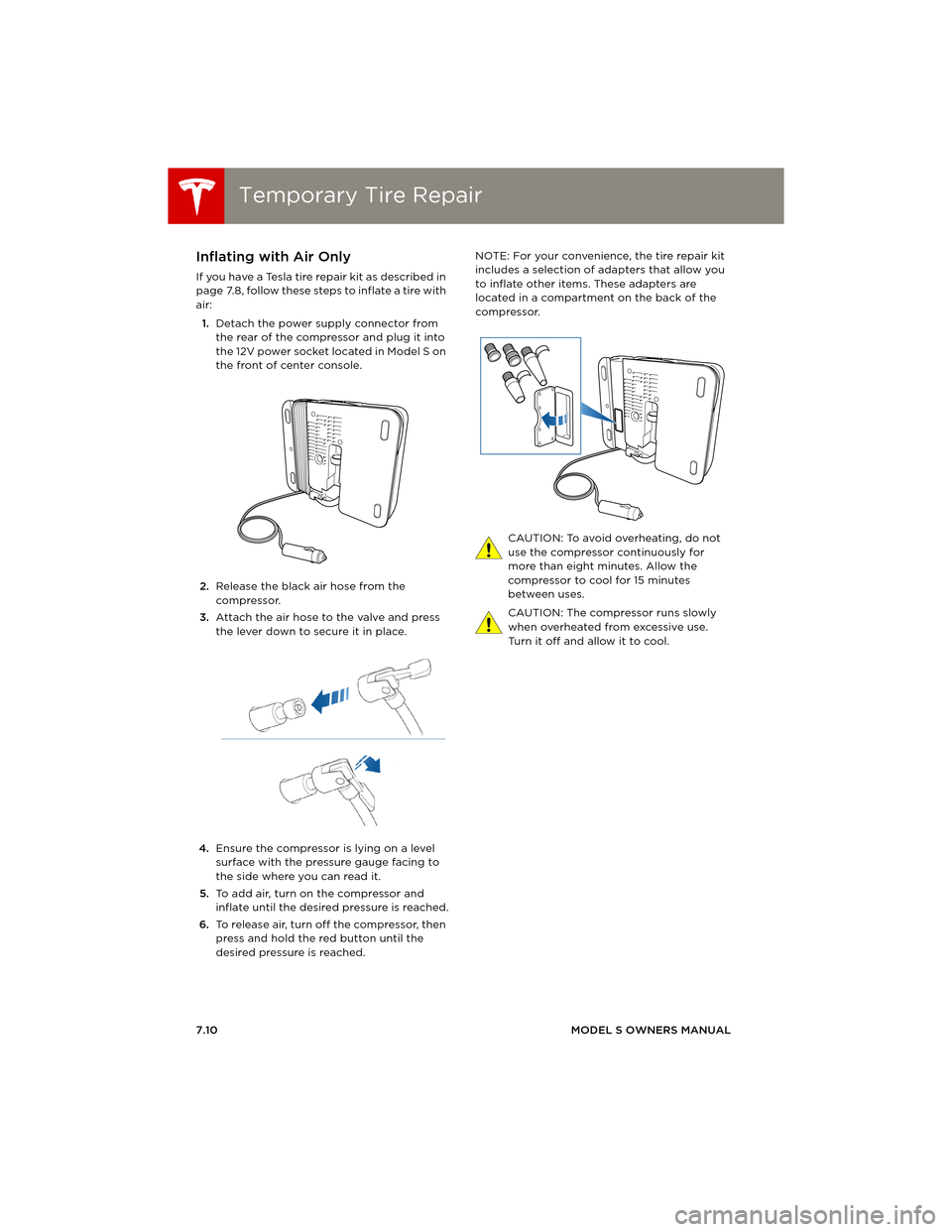
Temporary Tire RepairTemporary Tire Repair
7.10MODEL S OWNERS MANUAL
Inflating with Air Only
If you have a Tesla tire repair kit as described in
page 7.8, follow these steps to inflate a tire with
air:
1.Detach the power supply connector from
the rear of the compressor and plug it into
the 12V power socket located in Model S on
the front of center console.
2.Release the black air hose from the
compressor.
3.Attach the air hose to the valve and press
the lever down to secure it in place.
4.Ensure the compressor is lying on a level
surface with the pressure gauge facing to
the side where you can read it.
5.To add air, turn on the compressor and
inflate until the desired pressure is reached.
6.To release air, turn off the compressor, then
press and hold the red button until the
desired pressure is reached.NOTE: For your convenience, the tire repair kit
includes a selection of adapters that allow you
to inflate other items. These adapters are
located in a compartment on the back of the
compressor.
CAUTION: To avoid overheating, do not
use the compressor continuously for
more than eight minutes. Allow the
compressor to cool for 15 minutes
between uses.
CAUTION: The compressor runs slowly
when overheated from excessive use.
Turn it off and allow it to cool.
book.book Page 10 Friday, July 19, 2013 12:53 PM
Page 109 of 152
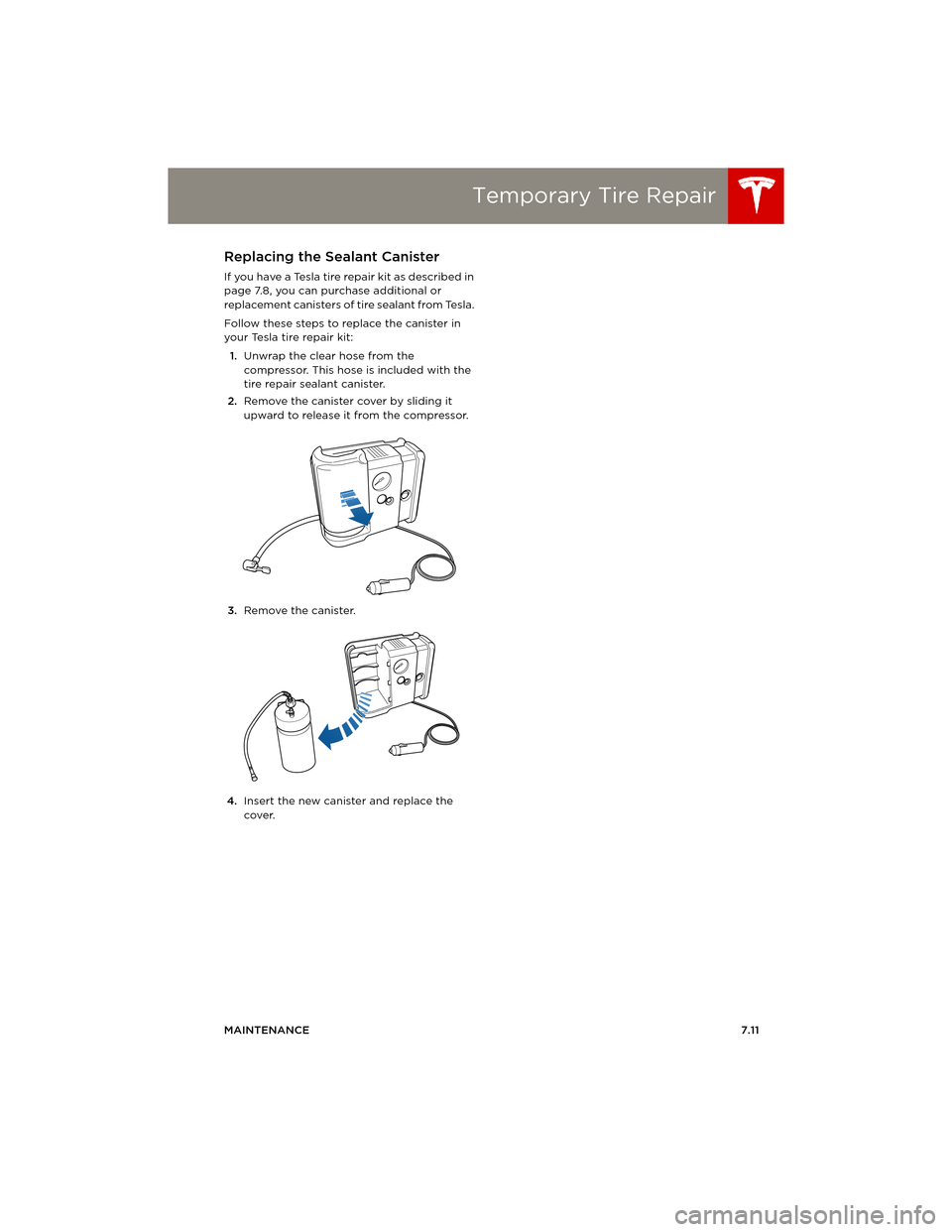
Temporary Tire Repair
MAINTENANCE7.11
Replacing the Sealant Canister
If you have a Tesla tire repair kit as described in
page 7.8, you can purchase additional or
replacement canisters of tire sealant from Tesla.
Follow these steps to replace the canister in
your Tesla tire repair kit:
1.Unwrap the clear hose from the
compressor. This hose is included with the
tire repair sealant canister.
2.Remove the canister cover by sliding it
upward to release it from the compressor.
3.Remove the canister.
4.Insert the new canister and replace the
cover.
book.book Page 11 Friday, July 19, 2013 12:53 PM
Page 110 of 152
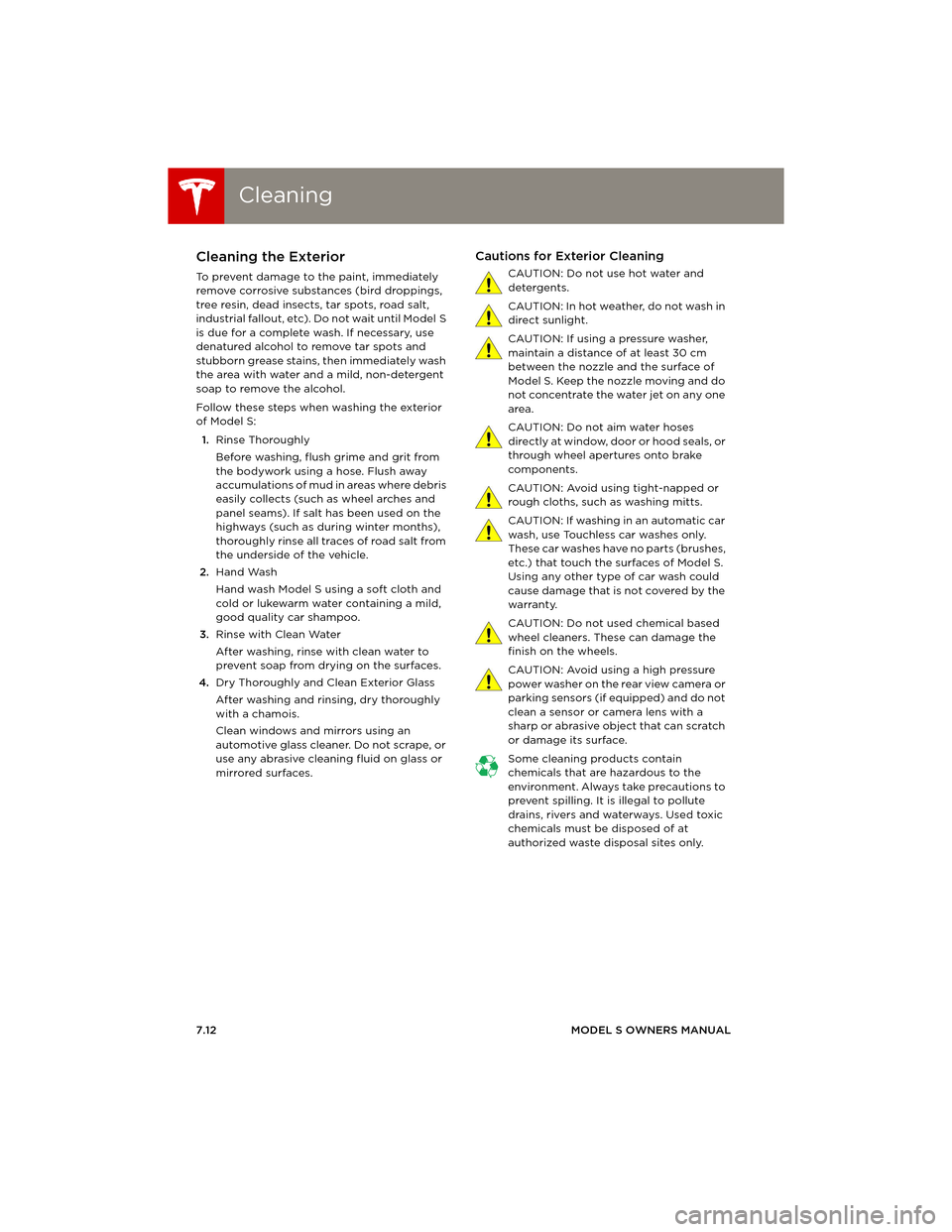
CleaningCleaning
7.12MODEL S OWNERS MANUAL
CleaningCleaning the Exterior
To prevent damage to the paint, immediately
remove corrosive substances (bird droppings,
tree resin, dead insects, tar spots, road salt,
industrial fallout, etc). Do not wait until Model S
is due for a complete wash. If necessary, use
denatured alcohol to remove tar spots and
stubborn grease stains, then immediately wash
the area with water and a mild, non-detergent
soap to remove the alcohol.
Follow these steps when washing the exterior
of Model S:
1.Rinse Thoroughly
Before washing, flush grime and grit from
the bodywork using a hose. Flush away
accumulations of mud in areas where debris
easily collects (such as wheel arches and
panel seams). If salt has been used on the
highways (such as during winter months),
thoroughly rinse all traces of road salt from
the underside of the vehicle.
2.Hand Wash
Hand wash Model S using a soft cloth and
cold or lukewarm water containing a mild,
good quality car shampoo.
3.Rinse with Clean Water
After washing, rinse with clean water to
prevent soap from drying on the surfaces.
4.Dry Thoroughly and Clean Exterior Glass
After washing and rinsing, dry thoroughly
with a chamois.
Clean windows and mirrors using an
automotive glass cleaner. Do not scrape, or
use any abrasive cleaning fluid on glass or
mirrored surfaces.
Cautions for Exterior Cleaning
CAUTION: Do not use hot water and
detergents.
CAUTION: In hot weather, do not wash in
direct sunlight.
CAUTION: If using a pressure washer,
maintain a distance of at least 30 cm
between the nozzle and the surface of
Model S. Keep the nozzle moving and do
not concentrate the water jet on any one
area.
CAUTION: Do not aim water hoses
d i r e c t l y a t w i n d o w, d o o r o r h o o d s e a l s , o r
through wheel apertures onto brake
components.
CAUTION: Avoid using tight-napped or
rough cloths, such as washing mitts.
CAUTION: If washing in an automatic car
wash, use Touchless car washes only.
These car washes have no parts (brushes,
etc.) that touch the surfaces of Model S.
Using any other type of car wash could
cause damage that is not covered by the
warranty.
CAUTION: Do not used chemical based
wheel cleaners. These can damage the
finish on the wheels.
CAUTION: Avoid using a high pressure
power washer on the rear view camera or
parking sensors (if equipped) and do not
clean a sensor or camera lens with a
sharp or abrasive object that can scratch
or damage its surface.
Some cleaning products contain
chemicals that are hazardous to the
environment. Always take precautions to
prevent spilling. It is illegal to pollute
drains, rivers and waterways. Used toxic
chemicals must be disposed of at
authorized waste disposal sites only.
book.book Page 12 Friday, July 19, 2013 12:53 PM